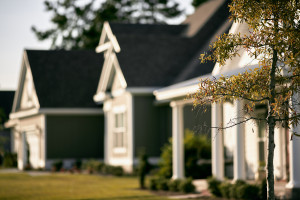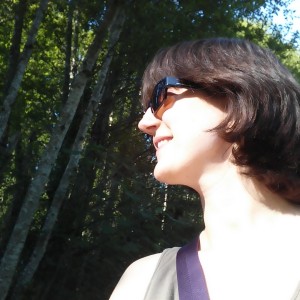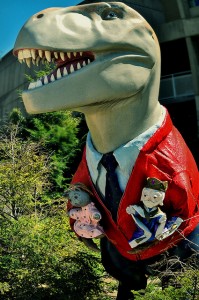“It’s that one, right there,” I tell my husband Ian as the car slows down and we peer out the window. “That’s where I lived.” I moved back to my old town nearly ten years ago, so I’ve seen my childhood house as an adult. But every time it’s still jarring. It feels like when I run into someone I used to babysit and they’re now in high school and my brain sort of cramps up like it can’t begin to process that they’re no longer five-years-old and just learning to read. It’s the same with my old neighborhood; it’s aged, too.
Several of the small two-story houses on the block, originally built by the railway, have been painted and none of the neighbors standing in their yards are the same. Some have moved but the elderly woman who lived to the right of my childhood house passed away about 15 years ago. Looking at her house flashes me back to her funeral service. But I quickly yank my train of thought in the direction of happier recollections: her short white hair and friendly smile, and how her house always smelled like old person soap — the kind that sits in a fancy dish in the bathroom and is shaped like shells and starfish. I find myself wishing we hadn’t run through her garden so much. And I wonder if whoever lives there now loves her forest of rhododendrons as much as she did.
 My old house is a small, white two-story home shaped like a square with its front door smack-dab in the middle and a pane window on each side that gives the impression of eyes, and a triangle roof perched on top. This is what all the houses on the block look like, although they come in a variety of colors. This is how children often draw houses, and I felt proud because it was how my house actually looked. It was as if this meant my house had achieved some high level of aesthetic perfection.
My old house is a small, white two-story home shaped like a square with its front door smack-dab in the middle and a pane window on each side that gives the impression of eyes, and a triangle roof perched on top. This is what all the houses on the block look like, although they come in a variety of colors. This is how children often draw houses, and I felt proud because it was how my house actually looked. It was as if this meant my house had achieved some high level of aesthetic perfection.
My mom’s green bird feeder is no longer hanging from the tree and the yard feels incomplete without it. I remember how the bird feeder would routinely spill seed all over the yard, which I’d incorporate into games with my toys. Usually it was food for stuffed animals, but one time I tried to eat a piece, myself; I discovered it wasn’t nearly as tasty as a bag of sunflower seeds. A pig my neighbors were babysitting, however, felt differently about the uncooked seeds. They brought the potbellied pig down so that we could take turns walking it on its leash. And the pig, to our delight and amusement, sucked up those pieces of bird seed just like a vacuum.
The front is no longer a lively brick red and is instead sporting a new coat of boring old grownup-grey paint. For anyone else driving by it’d be just a small porch, just like any other small front porch on the street. But I know that in a past life it was a clubhouse, a detective agency, a shelter during extreme — and extremely unrealistic — natural disasters, and a queen’s throne when my bossy best friend got to pick the game and wanted to spend the afternoon sitting smugly on the steps of my house as she ordered us around. It was also where I’d stand as I screamed at my best friend when we fought: “We’re not friends anymore! I’m never going to play with you again! Never ever!” After melodramatically slamming the front door behind me, I’d be greeted by my mother with that you-just-disturbed-the-entire-neighborhood-and-I’m-not-happy-about-it look that I was a little too familiar with.
The patch of grass in the front yard looks so tiny now, but I had the biggest front yard out of all my neighborhood friends. This meant all the good games took place in my front yard. During the summer we’d sometimes flip our bicycles upside down and place them in a circle and pretend it was a fort. During the winter, when it finally snowed, we’d attempt making the snow equivalency of our bicycle fort. But because we were in the Seattle area our winters weren’t very snowy, so by the time we’d built a snow-wall we would’ve used up all the snow in my front yard. We’d have half a fort, a wall we were proud of, but the snow would be gone, the grass would be showing. And there was nothing left to have a snowball fight with. There was never enough snow, I think.
“Well, this is where I grew up,” I tell Ian with a shrug as the car stops for just a moment so we can look. I can’t explain how much it’s changed, and I don’t try. It feels smaller now, duller. It’s as if that wild, vibrant childhood magic faded and left an ordinary, run-of-the-mill neighborhood standing in its place. “It’s changed a lot since when I was a kid,” I say. It’s no longer the same neighborhood or the same house. But perhaps the biggest change is that I’m not the same little girl running barefoot in my front yard. That little girl, like the neighborhood she once loved, now only exists in memories.
*****
 “That’s Where I Lived” was written by Kelsey L. Munger. Kelsey is a sixth generation Pacific Northwest native. Aside from three and a half months spent living in a very tiny town in Hungary among the sunflower fields, she has always lived in or just outside beautiful, rainy (sometimes a little moldy) Seattle, WA. Kelsey blogs at KelseyMunger.com and can be found on Twitter at @KelseyLMunger.
“That’s Where I Lived” was written by Kelsey L. Munger. Kelsey is a sixth generation Pacific Northwest native. Aside from three and a half months spent living in a very tiny town in Hungary among the sunflower fields, she has always lived in or just outside beautiful, rainy (sometimes a little moldy) Seattle, WA. Kelsey blogs at KelseyMunger.com and can be found on Twitter at @KelseyLMunger.

